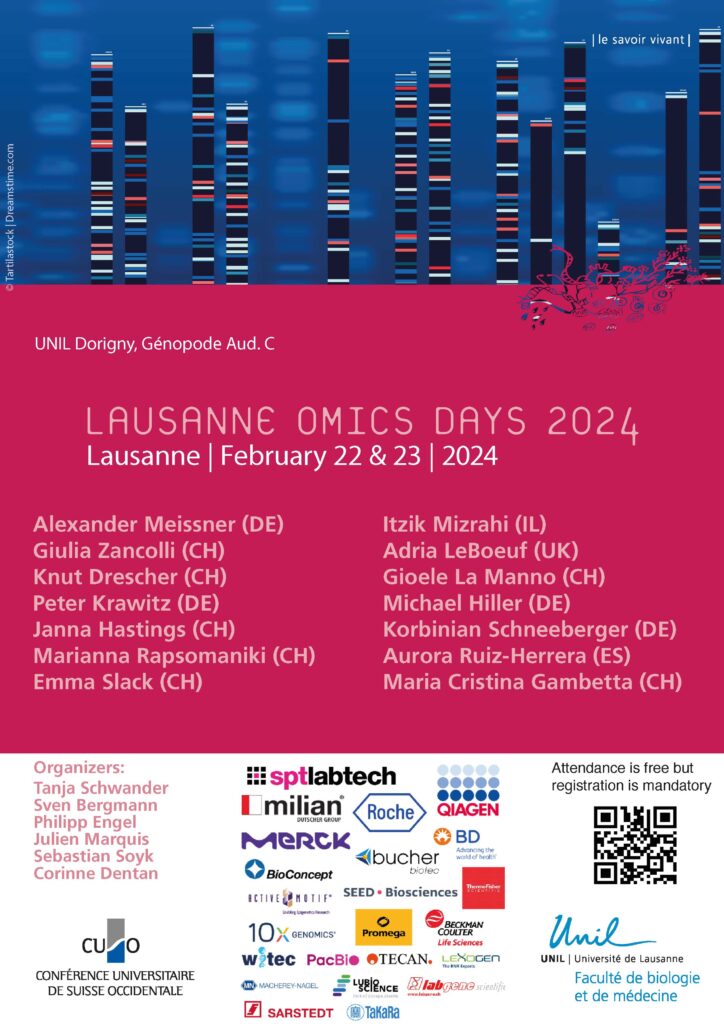Thanks to all the participants at the CIG Snow Day 2024


This year, the scope of the Lausanne Genomics Days has broadened since it becomes the Lausanne Omics Days. It is still a 2-days international conference meant to share advances in genomics and their impact on biological research, applied to a wide range of topics(it does involve 5 UNIL departments CIG, DBC, DBMV, DEE, and DMF).
It will take at UNIL / Genopode on February Thursday 22nd and Friday 23rd.
The conference offers 4 sessions:
For detailed program and more information, please visit the event webpage
Registration is FREE of charge. Still, it is mandatory for organization purpose, in particular ensuring that there will not be food wasted (coffee breaks, lunch and apero are offered).
HERE is the direct link for registration
Attendance is worth 0.5 ECTS
Best regards
Julien Marquis, on behalf of the L0D2024 organization team
Head of Lausanne Genomics Technologies Facility (GTF)

Konstantinos Kompotis # 1 2, Géraldine M Mang # 1, Jeffrey Hubbard 1, Sonia Jimenez 1, Yann Emmenegger 1, Christos Polysopoulos 3, Charlotte N Hor 1, Leonore Wigger 4, Sébastien S Hébert 5 6, Valérie Mongrain 7 8 9, Paul Franken 1
. 2024 Jan 16;121(3):e2220532121.
doi: 10.1073/pnas.2220532121. Epub 2024 Jan 11.
Free article
MicroRNAs (miRNAs) are key post-transcriptional regulators of gene expression that have been implicated in a plethora of neuronal processes. Nevertheless, their role in regulating brain activity in the context of sleep has so far received little attention. To test their involvement, we deleted mature miRNAs in post-mitotic neurons at two developmental ages, i.e., in early adulthood using conditional Dicer knockout (cKO) mice and in adult mice using an inducible conditional Dicer cKO (icKO) line. In both models, electroencephalographic (EEG) activity was affected and the response to sleep deprivation (SD) altered; while the rapid-eye-movement sleep (REMS) rebound was compromised in both, the increase in EEG delta (1 to 4 Hz) power during non-REMS (NREMS) was smaller in cKO mice and larger in icKO mice compared to controls. We subsequently investigated the effects of SD on the forebrain miRNA transcriptome and found that the expression of 48 miRNAs was affected, and in particular that of the activity-dependent miR-709. In vivo inhibition of miR-709 in the brain increased EEG power during NREMS in the slow-delta (0.75 to 1.75 Hz) range, particularly after periods of prolonged wakefulness. Transcriptome analysis of primary cortical neurons in vitro revealed that miR-709 regulates genes involved in glutamatergic neurotransmission. A subset of these genes was also affected in the cortices of sleep-deprived, miR-709-inhibited mice. Our data implicate miRNAs in the regulation of EEG activity and indicate that miR-709 links neuronal activity during wakefulness to brain synchrony during sleep through the regulation of glutamatergic signaling.
Javier Jurado-Aguilar 1, Emma Barroso 1, Maribel Bernard 1, Meijian Zhang 1, Mona Peyman 1, Patricia Rada 2, Ángela M Valverde 2, Walter Wahli 3, Xavier Palomer 1, Manuel Vázquez-Carrera 4
. 2024 Jan 3:152:155772.
doi: 10.1016/j.metabol.2023.155772. Online ahead of print.
Introduction: The levels of the cellular energy sensor AMP-activated protein kinase (AMPK) have been reported to be decreased via unknown mechanisms in the liver of mice deficient in growth differentiation factor 15 (GDF15). This stress response cytokine regulates energy metabolism mainly by reducing food intake through its hindbrain receptor GFRAL.
Chiara Auwerx 1 2 3 4, Maarja Jõeloo 5 6, Marie C Sadler 7 8 9, Nicolò Tesio 10, Sven Ojavee 7 8, Charlie J Clark 10, Reedik Mägi 6; Estonian Biobank Research Team; Alexandre Reymond # 11, Zoltán Kutalik # 12 13 14
Genome Med. 2024 Jan 8;16(1):5. doi: 10.1186/s13073-023-01265-5.
Background: Copy-number variations (CNVs) have been associated with rare and debilitating genomic disorders (GDs) but their impact on health later in life in the general population remains poorly described.
Nikhil R Gandasi 1 2, Rui Gao 3, Lakshmi Kothegala 1, Abigail Pearce 4, Cristiano Santos 1, Samuel Acreman 1 3, Davide Basco 5, Anna Benrick 1, Margarita V Chibalina 3, Anne Clark 3, Claudia Guida 3, Matthew Harris 4, Paul R V Johnson 6 7, Jakob G Knudsen 8, Jinfang Ma 3, Caroline Miranda 1 3, Makoto Shigeto 3, Andrei I Tarasov 3 9, Ho Yan Yeung 4, Bernard Thorens 5, Ingrid W Asterholm 1, Quan Zhang 3, Reshma Ramracheya 3, Graham Ladds 4, Patrik Rorsman 10 11 12 13
Affiliations expand
Aims/hypothesis: Diabetes mellitus is associated with impaired insulin secretion, often aggravated by oversecretion of glucagon. Therapeutic interventions should ideally correct both defects. Glucagon-like peptide 1 (GLP-1) has this capability but exactly how it exerts its glucagonostatic effect remains obscure. Following its release GLP-1 is rapidly degraded from GLP-1(7-36) to GLP-1(9-36). We hypothesised that the metabolite GLP-1(9-36) (previously believed to be biologically inactive) exerts a direct inhibitory effect on glucagon secretion and that this mechanism becomes impaired in diabetes.